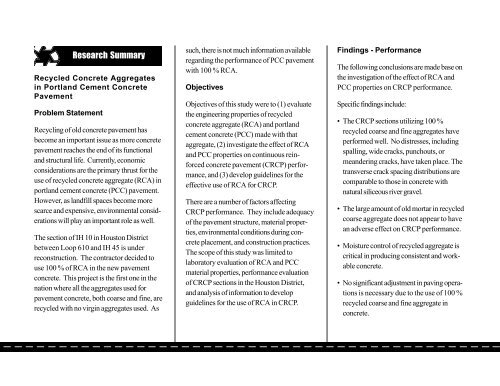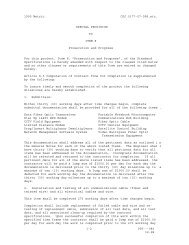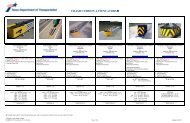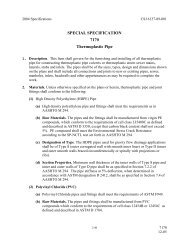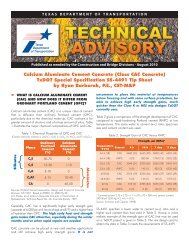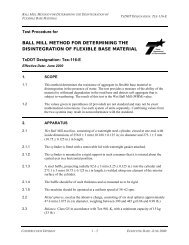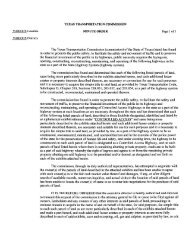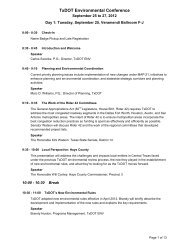Crushed Concrete - FTP Directory Listing
Crushed Concrete - FTP Directory Listing
Crushed Concrete - FTP Directory Listing
Create successful ePaper yourself
Turn your PDF publications into a flip-book with our unique Google optimized e-Paper software.
Research Summary<br />
Recycled <strong>Concrete</strong> Aggregates<br />
in Portland Cement <strong>Concrete</strong><br />
Pavement<br />
Problem Statement<br />
Recycling of old concrete pavement has<br />
become an important issue as more concrete<br />
pavement reaches the end of its functional<br />
and structural life. Currently, economic<br />
considerations are the primary thrust for the<br />
use of recycled concrete aggregate (RCA) in<br />
portland cement concrete (PCC) pavement.<br />
However, as landfill spaces become more<br />
scarce and expensive, environmental considerations<br />
will play an important role as well.<br />
The section of IH 10 in Houston District<br />
between Loop 610 and IH 45 is under<br />
reconstruction. The contractor decided to<br />
use 100 % of RCA in the new pavement<br />
concrete. This project is the first one in the<br />
nation where all the aggregates used for<br />
pavement concrete, both coarse and fine, are<br />
recycled with no virgin aggregates used. As<br />
such, there is not much information available<br />
regarding the performance of PCC pavement<br />
with 100 % RCA.<br />
Objectives<br />
Objectives of this study were to (1) evaluate<br />
the engineering properties of recycled<br />
concrete aggregate (RCA) and portland<br />
cement concrete (PCC) made with that<br />
aggregate, (2) investigate the effect of RCA<br />
and PCC properties on continuous reinforced<br />
concrete pavement (CRCP) performance,<br />
and (3) develop guidelines for the<br />
effective use of RCA for CRCP.<br />
There are a number of factors affecting<br />
CRCP performance. They include adequacy<br />
of the pavement structure, material properties,<br />
environmental conditions during concrete<br />
placement, and construction practices.<br />
The scope of this study was limited to<br />
laboratory evaluation of RCA and PCC<br />
material properties, performance evaluation<br />
of CRCP sections in the Houston District,<br />
and analysis of information to develop<br />
guidelines for the use of RCA in CRCP.<br />
Findings - Performance<br />
The following conclusions are made base on<br />
the investigation of the effect of RCA and<br />
PCC properties on CRCP performance.<br />
Specific findings include:<br />
• The CRCP sections utilizing 100 %<br />
recycled coarse and fine aggregates have<br />
performed well. No distresses, including<br />
spalling, wide cracks, punchouts, or<br />
meandering cracks, have taken place. The<br />
transverse crack spacing distributions are<br />
comparable to those in concrete with<br />
natural siliceous river gravel.<br />
• The large amount of old mortar in recycled<br />
coarse aggregate does not appear to have<br />
an adverse effect on CRCP performance.<br />
• Moisture control of recycled aggregate is<br />
critical in producing consistent and workable<br />
concrete.<br />
• No significant adjustment in paving operations<br />
is necessary due to the use of 100 %<br />
recycled coarse and fine aggregate in<br />
concrete.


